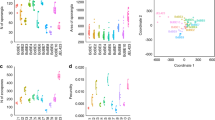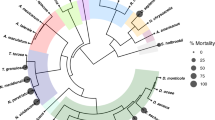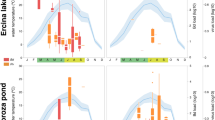Abstract
Emerging fungal pathogens pose a greater threat to biodiversity than any other parasitic group1, causing declines of many taxa, including bats, corals, bees, snakes and amphibians1,2,3,4. Currently, there is little evidence that wild animals can acquire resistance to these pathogens5. Batrachochytrium dendrobatidis is a pathogenic fungus implicated in the recent global decline of amphibians6. Here we demonstrate that three species of amphibians can acquire behavioural or immunological resistance to B. dendrobatidis. Frogs learned to avoid the fungus after just one B. dendrobatidis exposure and temperature-induced clearance. In subsequent experiments in which B. dendrobatidis avoidance was prevented, the number of previous exposures was a negative predictor of B. dendrobatidis burden on frogs and B. dendrobatidis-induced mortality, and was a positive predictor of lymphocyte abundance and proliferation. These results suggest that amphibians can acquire immunity to B. dendrobatidis that overcomes pathogen-induced immunosuppression7,8,9 and increases their survival. Importantly, exposure to dead fungus induced a similar magnitude of acquired resistance as exposure to live fungus. Exposure of frogs to B. dendrobatidis antigens might offer a practical way to protect pathogen-naive amphibians and facilitate the reintroduction of amphibians to locations in the wild where B. dendrobatidis persists. Moreover, given the conserved nature of vertebrate immune responses to fungi5 and the fact that many animals are capable of learning to avoid natural enemies10, these results offer hope that other wild animal taxa threatened by invasive fungi might be rescued by management approaches based on herd immunity.
This is a preview of subscription content, access via your institution
Access options
Subscribe to this journal
Receive 51 print issues and online access
$199.00 per year
only $3.90 per issue
Buy this article
- Purchase on Springer Link
- Instant access to full article PDF
Prices may be subject to local taxes which are calculated during checkout



Similar content being viewed by others
References
Fisher, M. C. et al. Emerging fungal threats to animal, plant and ecosystem health. Nature 484, 186–194 (2012)
Blehert, D. S. et al. Bat white-nose syndrome: an emerging fungal pathogen? Science 323, 227 (2009)
Cameron, S. A. et al. Patterns of widespread decline in North American bumble bees. Proc. Natl Acad. Sci. USA 108, 662–667 (2011)
Allender, M. C. et al. Chrysosporium sp. infection in eastern massasauga rattlesnakes. Emerg. Infect. Dis. 17, 2383–2384 (2011)
Sexton, A. C. & Howlett, B. J. Parallels in fungal pathogenesis on plant and animal hosts. Eukaryot. Cell 5, 1941–1949 (2006)
Stuart, S. N. et al. Status and trends of amphibian declines and extinctions worldwide. Science 306, 1783–1786 (2004)
Fites, J. S. et al. The invasive chytrid fungus of amphibians paralyzes lymphocyte responses. Science 342, 366–369 (2013)
Rosenblum, E. B. et al. Genome-wide transcriptional response of Silurana (Xenopus) tropicalis to infection with the deadly chytrid fungus. PLoS ONE 4, e6494 (2009)
Ribas, L. et al. Expression profiling the temperature-dependent amphibian response to infection by Batrachochytrium dendrobatidis. PLoS ONE 4, e8408 (2009)
Chivers, D. P. & Smith, R. J. F. Chemical alarm signalling in aquatic predator-prey systems: A review and prospectus. Ecoscience 5, 338–352 (1998)
Durrant, W. E. & Dong, X. Systemic acquired resistance. Annu. Rev. Phytopathol. 42, 185–209 (2004)
Woodhams, D. C. et al. Mitigating amphibian disease: strategies to maintain wild populations and control chytridiomycosis. Front. Zool. 8, 8 (2011)
Briggs, C. J., Knapp, R. A. & Vredenburg, V. T. Enzootic and epizootic dynamics of the chytrid fungal pathogen of amphibians. Proc. Natl Acad. Sci. USA 107, 9695–9700 (2010)
Venesky, M. D., Raffel, T. R., McMahon, T. A. & Rohr, J. R. Confronting inconsistencies in the amphibian-chytridiomycosis system: implications for disease management. Biol. Rev. Camb. Philos. Soc. 89, 477–483 (2014)
Richmond, J. Q., Savage, A. E., Zamudio, K. R. & Rosenblum, E. B. Toward immunogenetic studies of amphibian chytridiomycosis: linking innate and acquired immunity. Bioscience 59, 311–320 (2009)
Rollins-Smith, L. A., Ramsey, J. P., Pask, J. D., Reinert, L. K. & Woodhams, D. C. Amphibian immune defenses against chytridiomycosis: impacts of changing environments. Integr. Comp. Biol. 51, 552–562 (2011)
Ramsey, J. P., Reinert, L. K., Harper, L. K., Woodhams, D. C. & Rollins-Smith, L. A. Immune defenses against Batrachochytrium dendrobatidis, a fungus linked to global amphibian declines, in the south african clawed frog, Xenopus laevis. Infect. Immun. 78, 3981–3992 (2010)
Savage, A. E. & Zamudio, K. R. MHC genotypes associate with resistance to a frog-killing fungus. Proc. Natl Acad. Sci. USA 108, 16705–16710 (2011)
Murphy, P. J., St-Hilaire, S. & Corn, P. S. Temperature, hydric environment, and prior pathogen exposure alter the experimental severity of chytridiomycosis in boreal toads. Dis. Aquat. Organ. 95, 31–42 (2011)
Cashins, S. D. et al. Prior infection does not improve survival against the amphibian disease chytridiomycosis. PLoS ONE 8, e56747 (2013)
Stice, M. J. & Briggs, C. J. Immunization is ineffective at preventing infection and mortality due to the amphibian chytrid fungus Batrachochytrium dendrobatidis. J. Wildl. Dis. 46, 70–77 (2010)
Shaw, S. D. et al. Experimental infection of self-cured Leiopelma archeyi with the amphibian chytrid Batrachochytrium dendrobatidis. Dis. Aquat. Organ. 92, 159–163 (2010)
Rohr, J. R., Swan, A., Raffel, T. R. & Hudson, P. J. Parasites, info-disruption, and the ecology of fear. Oecologia 159, 447–454 (2009)
Kiesecker, J. M., Skelly, D. K., Beard, K. H. & Preisser, E. Behavioral reduction of infection risk. Proc. Natl Acad. Sci. USA 96, 9165–9168 (1999)
Rollins-Smith, L. A., Parsons, S. C. V. & Cohen, N. During frog ontogeny, PHA and Con-A responsiveness of splenocytes precedes that of thymocytes. Immunology 52, 491–500 (1984)
Rollins-Smith, L. A. et al. Immune defenses of Xenopus laevis against Batrachochytrium dendrobatidis. Front. Biosci. S1, 68–91 (2009)
Pawelec, G., Ehninger, G., Rehbein, A., Schaudt, K. & Jaschonek, K. Comparison of the immunosuppressive activities of the antimycotic agents, intraconazole, fluconazole, ketoconazole and miconazole on human T-cells. Int. J. Immunopharmacol. 13, 299–304 (1991)
Venesky, M. D., Mendelson, J. R., Stiling, P., Sears, B. F. & Rohr, J. R. Selecting for tolerance against pathogens and herbivores to enhance success of reintroduction and translocation. Conserv. Biol. 26, 586–592 (2012)
McMahon, T. A. et al. Chytrid fungus Batrachochytrium dendrobatidis has nonamphibian hosts and releases chemicals that cause pathology in the absence of infection. Proc. Natl Acad. Sci. USA 110, 210–215 (2013)
Hyatt, A. D. et al. Diagnostic assays and sampling protocols for the detection of Batrachochytrium dendrobatidis. Dis. Aquat. Organ. 73, 175–192 (2007)
Acknowledgements
We thank W. Holden and J. Pask for their assistance with the immunological assays, J. Cohen for comments on the manuscript, and our undergraduate assistants H. Folse, S. Lopez, L. Soto, S. Hekkanen and E. Creasey. We also thank V. Vasquez and J. Longcore for providing the Bd isolates used in these experiments. Funds were provided by grants from the National Science Foundation (DEB 0516227 and EF-1241889 to J.R.R. and IOS-1121758 to L.A.R.-S.), the National Institutes of Health (R01GM109499 to J.R.R.), the US Department of Agriculture (NRI 2006-01370 and 2009-35102-0543 to J.R.R.), the US Environmental Protection Agency grant (STAR R83-3835 and CAREER 83518801 to J.R.R.), and the NSF RCN “Refining and Diversifying Ecoimmunology”. The funders had no role in study design, data collection and analysis, decision to publish, or preparation of the manuscript.
Author information
Authors and Affiliations
Contributions
T.A.M., T.R.R., J.R.R., B.F.S., N.T.H. and J.M.B. conceived and designed the first immunological resistance experiment, T.A.M., J.R.R., B.F.S., S.M.B., N.T.H., N.O. and J.M.B conceived and designed the second immunological resistance experiment, M.D.V. and J.R.R. conceived and designed the behavioural resistance experiment. T.A.M. directed the first and second immunological resistance experiments and M.D.V. directed the behavioural resistance experiments. T.A.M., B.F.S., S.M.B., N.T.H., J.M.B., G.L., N.T., S.Y. and M.D.V. conducted the first and second immunological resistance experiments; M.D.V. and K.D. conducted the behavioural resistance experiments, and T.A.M., L.K.R., J.S.F. and L.A.R.-S. conducted the antimicrobial peptide collection and lymphocyte assays. T.A.M. and J.R.R. conducted the statistical analyses for the first and second immunological resistance experiments and D.J.C. consulted on these analyses; M.D.V. and J.R.R. conducted the statistical analyses for the behavioural resistance experiment. J.R.R. wrote the manuscript and handled all submissions and revisions. T.A.M. and B.F.S. wrote parts of the methods, and all authors contributed to its editing.
Corresponding authors
Ethics declarations
Competing interests
The authors declare no competing financial interests.
Extended data figures and tables
Extended Data Figure 1 Cumulative survival of Osteopilus septentrionalis.
a, b, Cuban treefrog survival in the first (a) and second immunological resistance experiments (b) with 1, 2, 3 or 4 exposures (previous infections were cleared with heat) to live Batrachochytrium dendrobatidis (Bd). Mortality was greater in the second immunological resistance experiment because we provided six weeks for Bd to grow on the frogs after the final Bd exposure, whereas the frogs were cleared of Bd after only 11 days of growth in the first immunological resistance experiment so that we had ample frog survival for subsequent immunological analyses. Naivety was based on the state of the frog before Bd exposure during the fourth exposure period; thus frogs exposed to Bd for the first time during the fourth exposure period were classified as naive because they had not previously been exposed to Bd.
Extended Data Figure 2 Effects of 1–4 exposures to Batrachochytrium dendrobatidis (Bd) on Bd abundance on frogs (Osteopilus septentrionalis; not standardized by weight).
a, b, Effects of exposures on mean Bd abundance (zoospore genome equivalents (GE) ± s.e.m.) after exposure period 3 in the first immunological resistance experiment (a) and exposure period 4 in the second immunological resistance experiment (live Bd exposures: circles and solid line; dead Bd exposures: squares and dotted line) (b). The best-fit lines are based on predicted values from the implemented zero-inflated negative binomial. Naivety was based on the state of the frog before Bd exposure during the focal exposure period (third or fourth exposure period depending on what is being displayed). Thus, frogs exposed to Bd for the first time during the focal exposure period were classified as naive because they had not previously been exposed to Bd.
Extended Data Figure 3 Effects of 0–4 exposures to live Batrachochytrium dendrobatidis (Bd) on the abundance and efficacy of skin peptides extracted from frogs (Osteopilus septentrionalis).
a, Mean (± s.e.) skin peptide abundance (n = 8, 9, 17, 17, and 18 for 0–4 Bd exposures, respectively). b, Mean (± 95% confidence interval) efficacy of skin peptides at inhibiting Bd, measured as the difference between Bd growth rate in the presence and absence of a standardized concentration of skin peptides (n = 8, 8, 10, 11, and 10 for 0–4 Bd exposures, respectively). See Methods for details on how Bd was quantified and growth rates were calculated. Naivety was based on the state of the frog before Bd exposure during the fourth exposure period; thus frogs exposed to Bd for the first time during the fourth exposure period were classified as naive because they had not previously been exposed to Bd.
Extended Data Figure 4 Cumulative survival of Osteopilus septentrionalis in the second immunological resistance experiment with 1, 2, 3 or 4 exposures to dead Batrachochytrium dendrobatidis (Bd) followed by an exposure to live Bd.
Naivety was based on the state of the frog before Bd exposure during the fourth exposure period; thus frogs exposed to Bd for the first time during the fourth exposure period were classified as naive because they had not previously been exposed to Bd.
Supplementary information
Supplementary Information
This file contains Supplementary Methods, Supplementary Results, a Supplementary Discussion and additional references. (PDF 316 kb)
Rights and permissions
About this article
Cite this article
McMahon, T., Sears, B., Venesky, M. et al. Amphibians acquire resistance to live and dead fungus overcoming fungal immunosuppression. Nature 511, 224–227 (2014). https://doi.org/10.1038/nature13491
Received:
Accepted:
Published:
Issue Date:
DOI: https://doi.org/10.1038/nature13491
This article is cited by
-
Metabolites of Xenorhabdus bacteria are potent candidates for mitigating amphibian chytridiomycosis
AMB Express (2023)
-
Signatures of functional bacteriome structure in a tropical direct-developing amphibian species
Animal Microbiome (2022)
-
Identification of a novel secreted metabolite cyclo(phenylalanyl-prolyl) from Batrachochytrium dendrobatidis and its effect on Galleria mellonella
BMC Microbiology (2022)
-
The amphibian microbiome exhibits poor resilience following pathogen-induced disturbance
The ISME Journal (2021)
-
Presence of low virulence chytrid fungi could protect European amphibians from more deadly strains
Nature Communications (2020)
Comments
By submitting a comment you agree to abide by our Terms and Community Guidelines. If you find something abusive or that does not comply with our terms or guidelines please flag it as inappropriate.



